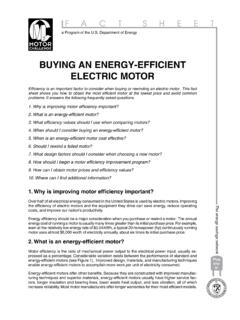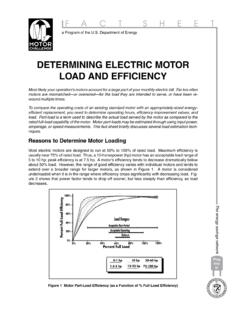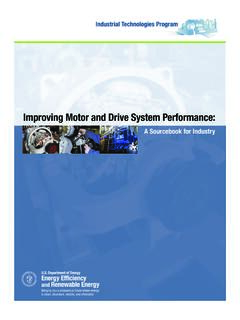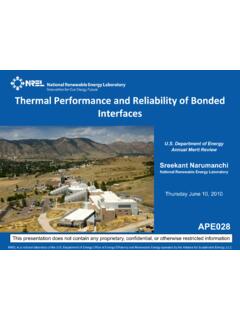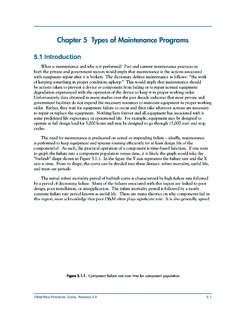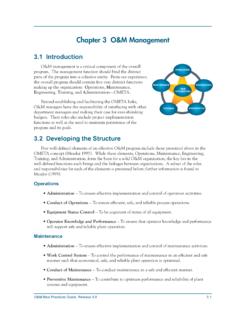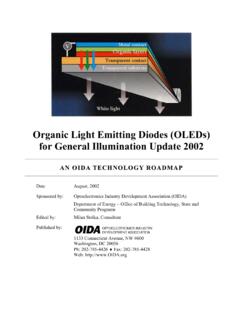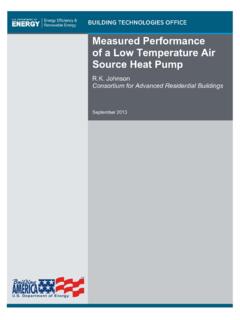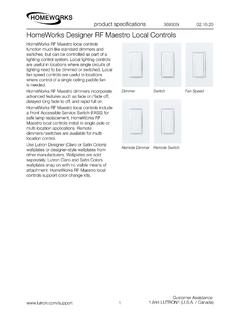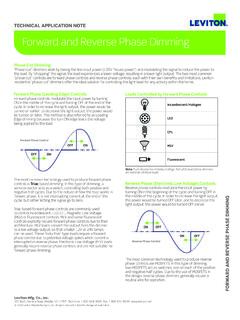Transcription of LED Dimming: What you need to know - Energy
1 dimming : What you need to know DOE SSL Program Michael Poplawski Pacific Northwest National Laboratory December 10, 2012 Why dim LED sources? Additional Energy savings Increased visual task performance Enhanced ambience Fewer light sources to specify, maintain, stock Enhanced space flexibility, satisfaction Demand response load shedding Potentially improved light source efficacy, lifetime 1 What s the big deal? dimming LED sources in the real world can be challenging, particularly with phase-cut dimmers Wide variation in LED source and dimmer characteristics Little can be assumed Not all claims are equal Difficult to predict 2 What you need to know LEDs are inherently dimmable LEDs typically need a Driver dimming an LED source can change the behavior of the Driver LED dimming performance is determined by Driver capability and compatibility with the dimming equipment Multiple compatibility issues are rooted in circuit level interactions between the LED Driver and dimmer What you think you know may no longer be valid 3 You can dim today, if you want to Good LED dimming solutions are available today with various trade-offs new standards, technologies in development user experiences should improve in future Chances for success correlated with willingness.
2 Ability to learn new things unfamiliar issues new standards, technologies Chances for success also correlated with willingness, ability to evaluate products first hand not new guidance color rendering, glare, etc. 4 What you need to figure out What your options are Where information and guidance is available What questions to ask What potential trade-offs are important, or not important to your application What your risk tolerance is How much you are willing to learn 5 Controlling current in simple (resistive) loads Resistive loads have linear current-voltage relationships I = (1/R) x V 100 75 For AC input, only care about Vrms 50 Time independency: Irms = (1/R) x Vrms 25 0 Irms 0 1 2 3 4 Vrms Resistive loads are bidirectional Applying Vrms results in the same Irms Irms = (1/R) x |Vrms| +Vrms Irms Irms +Vrms 6 +Vrms Irms Incandescent sources are simple (resistive) loads Incandescent sources electrically behave like resistors (unlike pretty much every other lighting technology) Incandescent sources effectively only care about Vrms Constant R at steady state R is a function of filament temperature Incandescent sources are bidirectional Applying Vrms results in the same Irms Irms Irms = (1/R) x |Vrms| Important caveat.
3 Thermal persistence +Vrms If I(t>0) 0 in resistor, no power consumption If I(t>0) 0 in incandescent source, light output continues as long as filament is hot (10s to 100s of milliseconds) 7 Controlling current in complex loads Complex loads contain complex electronic devices ( capacitors, inductors) Complex loads contain devices which store Energy Complex loads contain devices with non-linear current-voltage relationships Complex loads contain devices with time-dependencies ( dv/dt, di/dt, on/off switching) Capacitors store Inductors store Energy Energy in electric fields in magnetic fields 8 Vled LEDs are complex loads LEDs are non-linear devices Different current-voltage relationships in different regions of operation Small change in voltage can equal large change in current (Average) current must (typically) be controlled LEDs are unidirectional (Forward) current only flows in one direction +Vled>Vth Light output only for forward current I 0 Iled Important caveat: fast response If I(t>0) 0 in diode, no power consumption +Vled>Vth If I(t>0) 0 in LED, no light output Careful attention to time where I 0 Iled 9 Black BoxLEDs (typically) need a Driver Vrms = 120V CCAC Power Black Box Non-linear Iled vs.
4 Vled relationship, together with manufacturing variation in Vf, mean LEDs are best regulated by controlling their current Typically, LEDs are operated (or Driven ) such that their (average) current is constant (Constant Current) Typically, power electronics components are used to create circuits which convert AC voltage into regulated LED constant (average) current 10 LED s are dimmable Constant Current Reduction Also known as CCR, Analog Varying LED current, LED always on Longer LED lifetime Lower current and temperature No noise generation Potentially higher efficacy at lower dimming (lower current) levels Does not create flicker Objectionable color shift? More difficult dimming regulation at deep dimming (low current) levels 100%60% 100%60%Relative Luminous FluxRelative Luminous Efficacy (Average) Forward Current (mA) (Average) Forward Current (mA) 11 LED s are dimmable Pulse Width Modulation Same LED current, varying LED on/off (typically) times Longer LED lifetime Less LED on time, lower temperature Good dimming regulation at deep dimming (same current) levels No color shift?
5 Potential noise generation PWM frequency is important Potentially undesirable flicker Minimum dimming level 100 80 60 40 20 0 100 80 60 40 20 0 Also known as PWM 50% PWM 1/Frequency Average Level 50% 50% 0 5 10152025 Time (mS) 25% PWM 1/Frequency 25% 75% Average Level 0 5 10152025 Time (mS) 12 dimming technologies Dimmer AC Power Hot Neutral Dimmed Hot Switched Hot (power) Dimmed Hot (signal)AC Power Hot Neutra l Phase-Cut Fluorescent 3-Wire Switched Hot (power) 0-10V +/ AC Power Hot Neutral DALI +/ AC Power Hot Neutral 0-10V DALI 13 Two main approaches to dimming Coincident AC power and control signal Phase-cut AC sine wave AC Forward or reverse phase Power 2-Wire (hot, dimmed hot) 3-Wire (hot, dimmed hot, neutral) AC Reduced amplitude AC sine- Power wave Separate AC power and control signal Fluorescent 3-Wire 0-10V AC DALI Power DMX512 PWM 14 Example: LED Luminaires with 0-10 Vdimmer LED Luminaire 1 LED Luminaire 2 LED Luminaire 3 0% 20% 40% 60% 80% 100% Light Source Output 100% 80% 60% 40% 20% 0% Control Input 15 LED luminaire 1 + 0-10V dimmer A ~50% dimmer ~25% dimmer ~0% dimmer Switch 100% dimmer ~75% dimmer 16 LED luminaire 2 + 0-10V dimmer A Switch ~50% dimmer ~25% dimmer ~0% dimmer 100% dimmer ~75% dimmer 17 LED luminaire 3 + 0-10V dimmer A ~50% dimmer ~25% dimmer ~0% dimmer Switch 100% dimmer ~75% dimmer 18 Sidebar: What is flicker?
6 Variation in time (modulation) of light output (luminous flux) Present in all traditional commercial electric light sources running on AC power Including incandescent, halogen , fluorescent, metal-halide Typically (but not always) periodic, and property of light source Whether you are aware of it or not Not to be confused with electrical flicker Noise on AC distribution line directly creates additional (light) modulation on resistive (incandescent) loads Not a property of the light source Measurement and reporting is not a standard practice for commercially available light sources 19 Sidebar: Who cares about flicker? Anyone who is sensitive Anyone responsible for human health, well-being and/or performance in spaces with electric lighting At-risk populations for specific impairments Photosensitive epileptics: 1 in 4000 Migraine sufferers Not all at-risk populations identified Young people Autistic people 20 Light SourceControlBasic lighting control block diagram Separate AC power and control signal AC PowerControl InputInput(Dial, Slider, Digital Number) Light SourceControl Control signal LightSource Output(Lumens)
7 AC Power Input Control Output Control Input Control output becomes light source input Light Source OutputLight Source Input Control Light SourceTransfer Function Transfer Function 21 Common control transfer functions Linear Square S 120% Control Output 100% 80% 60% 40% 20% 0% Control Input 0% 20% 40% 60% 80% 100% 22 Different dimmer manufacturers target different transfer functions Manufacturer A Manufacturer B Manufacturer C Linear Square S 0-10V Control Output 12 10 8 6 4 2 0 0-10V Control Input 0% 20% 40% 60% 80% 100% 23 Different LED source manufacturers target different transfer functions Light Source Output Manufacturer A (Square) Manufacturer B (Linear) 100% 80% 60% 40% 20% 0% 0-10V Light Source Input 0 1 2 3 4 5 6 7 8 910 24 Sometimes this works Square Control + Linear Light Source Light Source Output 100% 80% 60% 40% 20% 0% 0% 20% 40% 60% 80% 100% Control Input 25 Sometimes this doesn t work Square Control + Square Light Source Light Source Output 100% 80% 60% 40% 20% 0% 0% 20% 40% 60% 80% 100% Control Input 26 dimming level Measured light light meter reading illuminance Perceived light visual interpretation affected by adaptation, eyedilation What does 50% dimmed mean?
8 Dimmer position Energy consumption measured light perceived light 20% measured 45% perceived Source: IESNA Lighting Handbook, 9th Edition 27 A word about power quality dimming an LED source can change the behavior of the Driver Efficiency can degrade, but may be offset by improving LED efficacy Flicker can be induced or increased Power quality, as quantitatively evaluated by the Power Factor and Total Harmonic Distortion metrics, can be degraded LED Drivers typically can not maintain consistent performance over a wide range of conditions Temperature Connected load Input voltage LED Driver performance varies with technology, cost 28 Sidebar: What is power quality? Displacements anddistortions to voltage and current waveforms Metrics Power Factor Total Harmonic Distortion Power Factor relates Active Power (P) andApparent Power (S) by PF = P/S Low(er) power factor loads DO NOT consume more Energy , BUT they DO draw more RMS current Total Harmonic Distortion (THD) THD-V THD-I Voltage waveform distortions typically created by generators Current waveform distortions typically created by loads Common standard for generators is to limit THD-V < 5% Common specification for loads it to limit THD-I < 20% 29 Sidebar: Who cares about power quality?
9 Electricity producers and consumers Increased current requirements Electricity transport (I2R)losses (<10%) Wire, circuit breaker, transformer, etc. sizing System issue; hard to quantify Can in some cases lead to electronic equipmentdamage, degradedperformance Lighting equipmentmanufacturers Voluntary requirements for lighting equipment in ANSI Most recent published version Revision under development System design tradeoffs for some LED sources Cost and size constraints for some LED sources 30 Light SourceControlWhat about incandescent dimming ? Coincident AC power and control signal Phase-cut AC sine wave AC Forward or reverse phase Power 2-Wire (hot, dimmed hot) 3-Wire (hot, dimmed hot, neutral) AC Power Reduced amplitude AC sine-wave Control Input(Dial, Slider, Digital Number) Light SourceControl Coincident AC power and control signal LightSourceAC Power OutputInput (Lumens) 31 Phase-cut vs. Sine-wave dimming Phase-cut control is the most commonly deployed dimming technology Large installed base NEMA estimates >150M Mostly analog (no neutral) Phase-Cut Dimmer Sine-Wave Dimmer 32 Phase-cut dimming was designed for incandescent sources Vrms = 120V Vrms = 120V Vrms = 120V Vrms = 120V Same (average) light output Vrms = 120V Vrms = 60V High performance Inexpensive Vrms adjuster Determines dimming performance 50% light output 33 Example: Incandescent source +phase-cut dimmers Similar dimming range, different dimming curves 34 Example: Incandescent source +phase-cut dimmers Reduced efficacy when dimmed 35 Black BoxPhase-cut dimming of LED light sources Different (average) light output Black Box Vrms = 120V Vrms = 120V Vrms = 120V Vrms = 120V Vrms = 120V Vrms = 60V High performance Controls current to LED Inexpensive Capability, compatibility Vrms adjuster determines dimming performance 36 Example.
10 LED source + phase-cutdimmers Varying dimming ranges and curves 37 Example: LED source + phase-cutdimmers Maintains efficacy when dimmed 38 Example: LED lamp 1 + phase-cutdimmer A Switch 100% dimmer ~75% dimmer ~50% dimmer ~25% dimmer ~0% dimmer 39 40 Example: LED lamp 1 + phase-cutdimmer B ~50% dimmer ~25% dimmer ~0% dimmer Switch 100% dimmer ~75% dimmer What s the big deal, again? dimming LED sources in the real world can be challenging, particularly with phase-cut dimmers Wide variation in LED source and dimmer characteristics Little can be assumed Not all claims are equal Difficult to predict Performance dimming range, curve Efficacy Flicker Power quality Compatibility Dead travel Popcorn Flashing, Ghosting Pop-on, Drop-out Audible noise Inoperability Premature failure 41 Phase-cut dimming challenges The behavior of an LED source on a circuit controlled by a phase-cut dimmer is a function of: 1.
